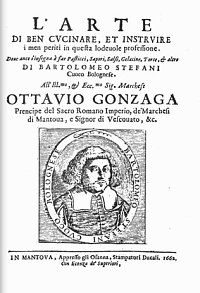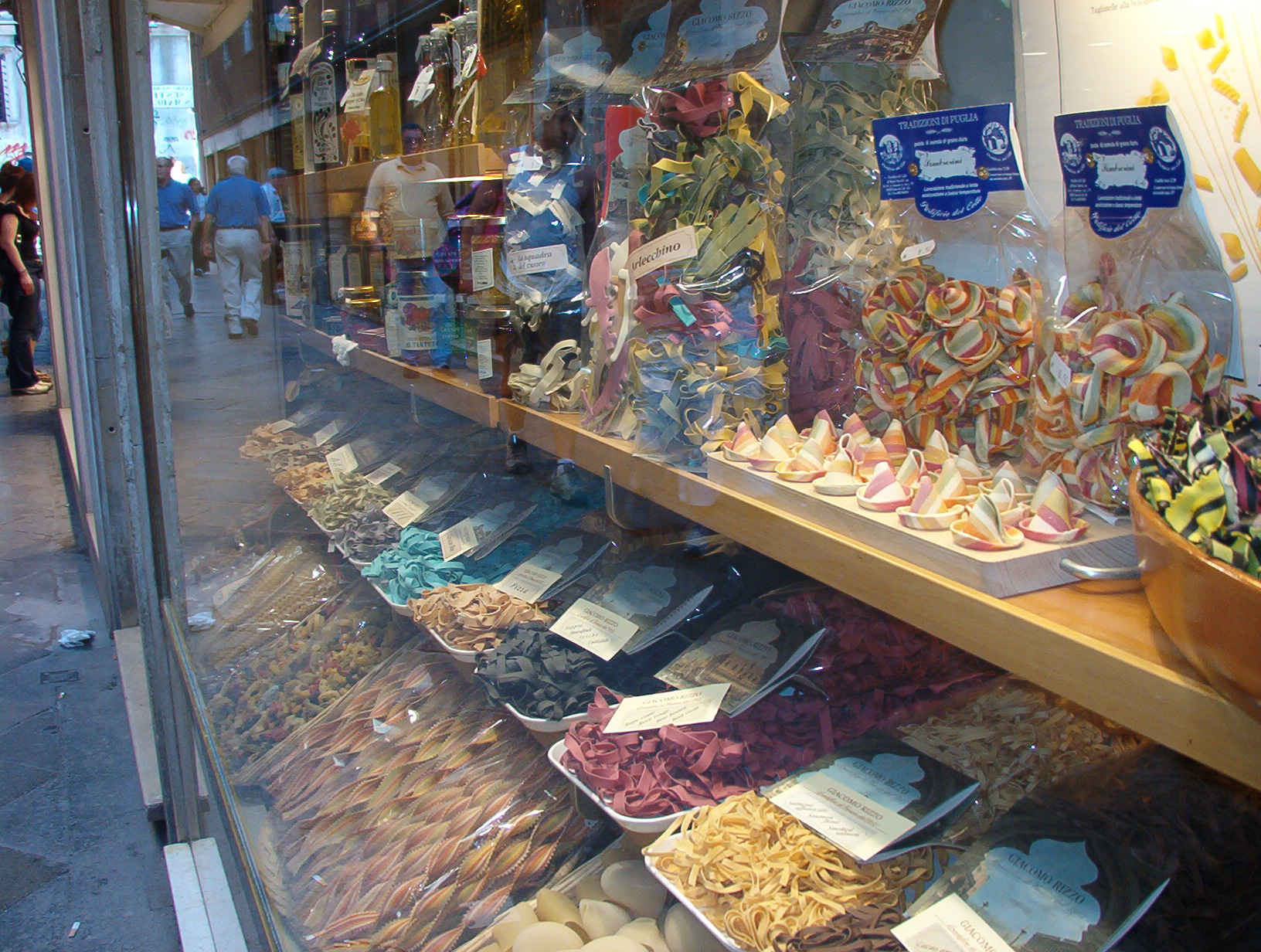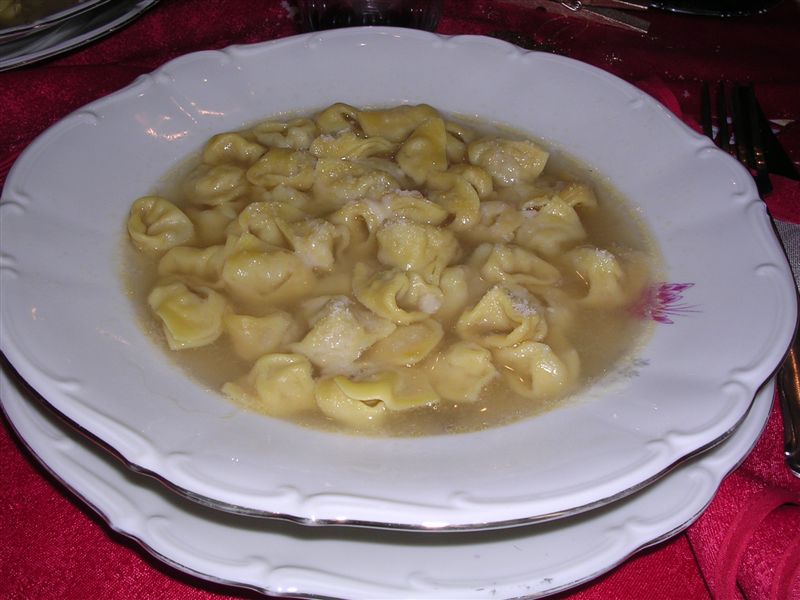|
Agnolini
Agnolini are a type of stuffed egg pasta originating from the province of Mantua (in the Mantuan dialect they are commonly called "agnulìn" or "agnulì") and are oftentimes eaten in soup or broth. The recipe for Agnolotti was first published in 1662 by Bartolomeo Stefani, a cook at the court of the Gonzaga family, in his book '' The art of cooking well''. Agnolini's recipe is passed down from generation to generation by Mantuan families. Agnolini are the main ingredient of soups of the Mantuan cuisine, usually consumed during holidays and important occasions. According to Mantuan tradition during Christmas Eve chicken broth with the Agnolini alongside other traditional Mantuan dishes such as the Agnolini's soup Sorbir d'agnoli, with abundant addition of parmesan cheese are consumed. Sorbir, to which red wine is added, generally Lambrusco, represents the opening to the Christmas lunch. Agnolini differ from the classic Emilian tortellini, to which they are similar, due ... [...More Info...] [...Related Items...] OR: [Wikipedia] [Google] [Baidu] |
Pasta
Pasta (, ; ) is a type of food typically made from an unleavened dough of wheat flour mixed with water or eggs, and formed into sheets or other shapes, then cooked by boiling or baking. Rice flour, or legumes such as beans or lentils, are sometimes used in place of wheat flour to yield a different taste and texture, or as a Gluten-free diet, gluten-free alternative. Pasta is a staple food of Italian cuisine. Pastas are divided into two broad categories: dried () and fresh (). Most dried pasta is produced commercially via an Food extrusion, extrusion process, although it can be produced at home. Fresh pasta is traditionally produced by hand, sometimes with the aid of simple machines.Hazan, Marcella (1992) ''Essentials of Classic Italian Cooking'', Knopf, Fresh pastas available in grocery stores are produced commercially by large-scale machines. Both dried and fresh pastas come in a number of shapes and varieties, with 310 specific forms known by over 1,300 documented names.Za ... [...More Info...] [...Related Items...] OR: [Wikipedia] [Google] [Baidu] |
List Of Pasta
There are many different varieties of pasta. They are usually sorted by size, being long (''pasta lunga''), short (''pasta corta''), stuffed (''ripiena''), cooked in broth (''pastina''), stretched (''strascinati'') or in dumpling-like form (''gnocchi/gnocchetti''). Yet, due to the variety of shapes and regional variants, "one man's ''gnocchetto'' can be another's ''strascinato''". Some pasta varieties are uniquely regional and not widely known; many types have different names based on region or language. For example, the cut rotelle is also called ''ruote'' in Italy and ''wagon wheels'' in the United States. Manufacturers and cooks often invent new shapes of pasta, or may rename pre-existing shapes for marketing reasons. Italian pasta names often end with the masculine plural diminutive suffixes ''-ini'', ''-elli'', ''-illi'', ''-etti'' or the feminine plurals ''-ine'', ''-elle'' etc., all conveying the sense of "little"; or with the augmentative suffixes ''-oni'', ''-one'', mea ... [...More Info...] [...Related Items...] OR: [Wikipedia] [Google] [Baidu] |
Italy
Italy ( it, Italia ), officially the Italian Republic, ) or the Republic of Italy, is a country in Southern Europe. It is located in the middle of the Mediterranean Sea, and its territory largely coincides with the homonymous geographical region. Italy is also considered part of Western Europe, and shares land borders with France, Switzerland, Austria, Slovenia and the enclaved microstates of Vatican City and San Marino. It has a territorial exclave in Switzerland, Campione. Italy covers an area of , with a population of over 60 million. It is the third-most populous member state of the European Union, the sixth-most populous country in Europe, and the tenth-largest country in the continent by land area. Italy's capital and largest city is Rome. Italy was the native place of many civilizations such as the Italic peoples and the Etruscans, while due to its central geographic location in Southern Europe and the Mediterranean, the country has also historically been home ... [...More Info...] [...Related Items...] OR: [Wikipedia] [Google] [Baidu] |
Christmas Eve
Christmas Eve is the evening or entire day before Christmas Day, the festival commemorating the birth of Jesus. Christmas Day is observed around the world, and Christmas Eve is widely observed as a full or partial holiday in anticipation of Christmas Day. Together, both days are considered one of the most culturally significant celebrations in Christendom and Western society. Christmas celebrations in the denominations of Western Christianity have long begun on Christmas Eve, due in part to the Christian liturgical day starting at sunset, a practice inherited from Jewish tradition and based on the story of Creation in the Book of Genesis: "And there was evening, and there was morning – the first day." Many churches still ring their church bells and hold prayers in the evening; for example, the Nordic Lutheran churches. Since tradition holds that Jesus was born at night (based in Luke 2:6-8), Midnight Mass is celebrated on Christmas Eve, traditionally at midnight, in c ... [...More Info...] [...Related Items...] OR: [Wikipedia] [Google] [Baidu] |
Types Of Pasta
Type may refer to: Science and technology Computing * Typing, producing text via a keyboard, typewriter, etc. * Data type, collection of values used for computations. * File type * TYPE (DOS command), a command to display contents of a file. * Type (Unix), a command in POSIX shells that gives information about commands. * Type safety, the extent to which a programming language discourages or prevents type errors. * Type system, defines a programming language's response to data types. Mathematics * Type (model theory) * Type theory, basis for the study of type systems * Arity or type, the number of operands a function takes * Type, any proposition or set in the intuitionistic type theory * Type, of an entire function ** Exponential type Biology * Type (biology), which fixes a scientific name to a taxon * Dog type, categorization by use or function of domestic dogs Lettering * Type is a design concept for lettering used in typography which helped bring about modern textual printin ... [...More Info...] [...Related Items...] OR: [Wikipedia] [Google] [Baidu] |
Tortellini
''Tortellini'' are pasta originally from the Italian region of Emilia (in particular Bologna and Modena). Traditionally they are stuffed with a mix of meat (pork loin, raw prosciutto, mortadella), Parmigiano Reggiano cheese, egg and nutmeg and served in capon broth (''in brodo di cappone''). In the area of origin they are usually sold fresh or home-made. Industrially packaged, dried, refrigerated, or frozen tortellini appear in many locations around the world, especially where there are large Italian communities. Origins The origin of tortellini is disputed; both Bologna and Modena, cities in Italy's Emilia-Romagna region, claim to be its birthplace. OxfordDictionaries.com traces the etymology of ''tortellini'' to the diminutive form of ''tortello'', itself a diminutive of ''torta'' ("cake" or "pie" in Italian). The recipe for a dish called "torteletti" appears in 1570 from Bartolomeo Scappi. Vincenzo Tanara's writings in the mid-17th century may be responsible for the pasta's r ... [...More Info...] [...Related Items...] OR: [Wikipedia] [Google] [Baidu] |
Cappelletti (pasta)
''Cappelletti'' are ring-shaped Italian pasta so called for the characteristic shape that resembles a hat (''cappello'' in Italian). Compared to ''tortellini'', they have a different shape, larger size, thicker dough and different filling. The origins of the recipe, very widespread on a territorial basis, are ancient, traditionally and historically linked to Emilia-Romagna and Marche.Cristina Ortolani, ''L'Italia della pasta'', Touring Editore, 2003, p. 86, ISBN 9788836529339. From these areas it then spread over the centuries, becoming a typical dish in various cities. Some recent sources specifically indicate the area in the Cesena-Ferrara-Reggio Emilia triangle as the place of origin, others report the Marche as a land where ''cappelletti'' are of ancient tradition. Production areas Emilia A first reference to this culinary preparation could perhaps be found linked to Ferrara, in a text dating back to 1556 by Cristoforo di Messisbugo, former cook of the Este court with Alfon ... [...More Info...] [...Related Items...] OR: [Wikipedia] [Google] [Baidu] |
Agnolotti
Agnolotti (; pms, agnolòt ) is a type of pasta typical of the Piedmont region of Italy, made with small pieces of flattened pasta dough, folded over a filling of roasted meat or vegetables. ''Agnolotti'' is the plural form of the Italian word ''agnolotto''. According to a legend, the origin of the name may come from a cook called Angiolino, or "Angelot", an individual from Montferrat who is said to be the inventor of the recipe. Agnolotti can be ''di magro'' or ''di grasso'' depending on their filling of vegetables or meat. Overview Although their primitive shape was semi-circular, traditionally agnolotti are of a square shape with sides of about one or two inches. However, they can also be of a smaller, rectangular shape when they are called agnolotti ''al plin''. ''Plin'' means "a pinch", because one pinches with thumb and forefinger between each mound of filling to close and seal the little pasta packets. ''Agnolotti'' ''al plin'' are almost always stuffed with meat. One of ... [...More Info...] [...Related Items...] OR: [Wikipedia] [Google] [Baidu] |
Tortellini
''Tortellini'' are pasta originally from the Italian region of Emilia (in particular Bologna and Modena). Traditionally they are stuffed with a mix of meat (pork loin, raw prosciutto, mortadella), Parmigiano Reggiano cheese, egg and nutmeg and served in capon broth (''in brodo di cappone''). In the area of origin they are usually sold fresh or home-made. Industrially packaged, dried, refrigerated, or frozen tortellini appear in many locations around the world, especially where there are large Italian communities. Origins The origin of tortellini is disputed; both Bologna and Modena, cities in Italy's Emilia-Romagna region, claim to be its birthplace. OxfordDictionaries.com traces the etymology of ''tortellini'' to the diminutive form of ''tortello'', itself a diminutive of ''torta'' ("cake" or "pie" in Italian). The recipe for a dish called "torteletti" appears in 1570 from Bartolomeo Scappi. Vincenzo Tanara's writings in the mid-17th century may be responsible for the pasta's r ... [...More Info...] [...Related Items...] OR: [Wikipedia] [Google] [Baidu] |
Lambrusco
Lambrusco (; ) is the name of both an Italian red wine grape and a wine made principally from said grape. The grapes and the wine originate from four zones in Emilia-Romagna and one in Lombardy―principally around the central provinces of Modena, Parma, Reggio-Emilia, and Mantua. The grape has a long winemaking history, with archaeological evidence indicating that the Etruscans cultivated the vine. J. Robinson ''Vines, Grapes & Wines'' pg 212 Mitchell Beazley 1986 In Roman times Lambrusco was highly valued for its productivity and high yields, with Cato the Elder stating that produce of two thirds of an acre could make enough wine to fill 300 amphoras. J. Robinson (ed) ''"The Oxford Companion to Wine"'' Third Edition pg 388-389 Oxford University Press 2006 The most highly rated of its wines are the frizzante (slightly sparkling) red wines, designed to be drunk young, from one of the eight Lambrusco denominazione di origine controllata (DOC) regions: Colli di Parma Lambrusc ... [...More Info...] [...Related Items...] OR: [Wikipedia] [Google] [Baidu] |
Parmesan Cheese
Parmesan ( it, Parmigiano Reggiano; ) is an Italian hard, granular cheese produced from cows’ milk and aged at least 12 months. It is named after two of the areas which produce it, the provinces A province is almost always an administrative division within a country or state. The term derives from the ancient Roman '' provincia'', which was the major territorial and administrative unit of the Roman Empire's territorial possessions ou ... of Province of Parma, Parma and Province of Reggio Emilia, Reggio Emilia (''Parmigiano'' is the Italian language, Italian adjective for Parma and ''Reggiano'' that for Reggio Emilia). In addition to Reggio Emilia and Parma, it is also produced in the part of Province of Bologna, Bologna west of the Reno (river), River Reno and in Province of Modena, Modena (all of the above being located in the Emilia-Romagna region), as well as in the part of Province of Mantua, Mantua (Lombardy) which is on the south bank of the Po (river), River Po. ... [...More Info...] [...Related Items...] OR: [Wikipedia] [Google] [Baidu] |



.jpg)


.jpg)
